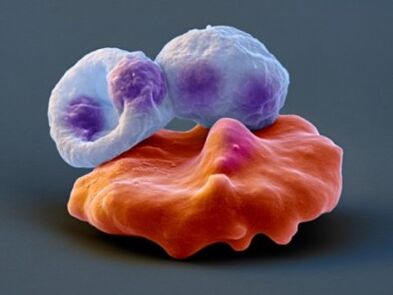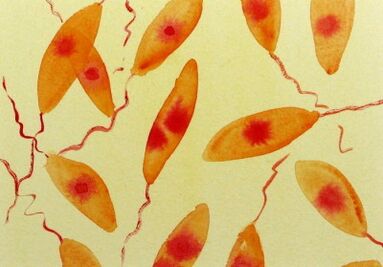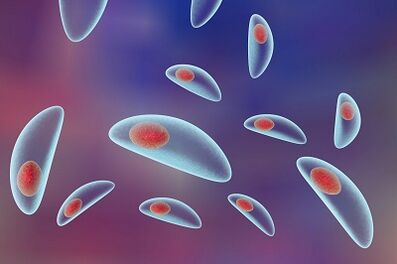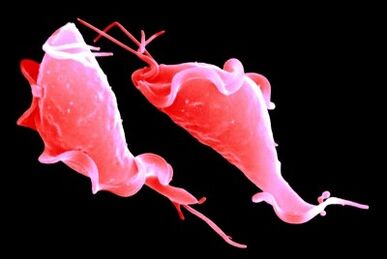
The simplest parasite is an organism adapted to invade and survive the cells and tissues of other organisms. The simplest parasites, like other protozoa, cannot live alone in an open environment, but must invade the body of another organism in order to gain protection and nutrition.
The simplest parasites and their types
The simplest organisms are eukaryotic systems that exist as structurally and functionally independent individual cells (including those that form species or colonies). Protozoa develop relatively complex subcellular features (membranes and organelles) that allow them to survive in harsh environments. Most protozoa are microscopic organisms, and only a few of them grow to be visible to the naked eye. As unicellular eukaryotes, they move to survive, feed, and reproduce.
There are the simplest parasites that cause problems. It is in our food, our soil and our water, and if they enter us, they can make us very sick.
Each different protozoa parasite can cause different diseases in our body. Some can cause serious diseases of the respiratory tract (air from the nose to the lungs) and the central nervous system (brain, cranial nerves and spinal cord), while others live in the intestines and are not fatal.

There are four types of protozoan parasites that are classified according to how they move:
- sarcoids are a group of amygdala that moves with false and contractions that change the shape of their cells;
- mastigophores move with the help of flagella;
- siliophores use cilia;
- sporozoites become inactive when they are mature.
Life cycles of protozoa parasites
Most protozoa have a very large reproductive potential because they have a short reproductive life, undergo rapid and consistent development, and produce many offspring asexually or sexually. These features are responsible for many of the simplest infections that quickly cause acute symptoms of the disease.
The developmental stages of protozoa parasites that occur inside the host usually consist of feeding on trophozoites and can be found intracellularly (inside the host cells) or extracellularly (in hollow organs, body fluids, or intercellular internodes). Although trophozoites are ideal for parasitic lifestyles, they are not very resistant to environmental conditions and do not live long outside their hosts. Protozoan parasites use one of four main methods of transmission from host to host: direct, fecal-oral, transmitted, and from predator to predator.
Ways of transmission of protozoa parasites to humans
- Direct transmission of parasites through close contact with the body - sexually (for example, Trichomonas fungi, which cause trichomoniasis in humans).
- Fecal-oral transmission of ecologically stable stages of cysts - parasites pass through the feces of one host and are transmitted to another by food or water (eg Entamoeba histolytica, Giardia duodenalis and Balantidium coli, all forms of fecal cysts causing amoeba), dysentery, giardiasis and balant).
- Transmission occurs when parasites are eaten by blood-sucking arthropods (insects or arachnids) and transmitted to new hosts with a single bite (e. g. , Plasmodium spp. Haemosporidia transmitted by tsetse flies and caused by Trypanosoma brucei and mosquitoes that cause sleep sickness). and causes malaria).
- Infection from a predator to a predator occurs when the simplest parasite gets stuck in the victim's tissues (eg, cows, goats, pigs) and is eaten by the predator (in our case, a human being).
The simplest human parasites and the diseases they cause
Acanthamoeba. This parasite infects a person's eyes or brain and causes exogenous amoebiasis. It can live in any part of the world. People can get contact lenses while cleaning them with tap water.
Babesiya. It infects red blood cells and causes a disease called babesiosis. Different types of parasites live in different parts of the world. It is transmitted by ticks when bitten.

Balantidium (Balantidium coli). It lives in the intestinal mucosa, causing ciliated dysentery called balantidiosis.
Blastocystis. This parasite infects the host's intestines. It enters humans through food contaminated with human or animal feces. The disease caused by this parasite is called blastocytosis.
Cryptosporidium (Cryptosporidium). It lives in the human gut. Spread all over the world. It enters the human body through food contaminated with human or animal feces.

Dysentery amoeba (Entamoeba histolytica). This simple parasite causes intestinal amebiasis. It is often found in areas with high population density, poor sanitation and tropical areas. It is transmitted through the faeces and mouth.
Giardia lamblia. Lives in the lumen of the small intestine. If people consume food or water contaminated with feces, inactive Giardia cysts can infect the body and cause intestinal giardiasis. It is especially dangerous for children and requires mandatory adherence to the treatment regimen.
Isospore (Isospora belli). Affects the epithelial cells of the small intestine. Spread all over the world. It is transmitted through the feces and mouth and is the causative agent of isosporia.
Leishmaniasis. Parasitizes a person's skin and internal organs. It exists in different forms all over the world. Some species are transmitted by mosquito bites.

Negleria (Naegleria fowleri). Because it lives in the human brain, it causes primary amoebic meningoencephalitis. Infection occurs through contaminated soil, pools and contaminated water.
Plasmodium (Plasmodium falciparum, P. vivax, P. ovale, P. malariae). Parasites enter red blood cells and cause malaria. Anopheles are found in tropical regions known as mosquitoes.
Rhinosporidium liver. It multiplies in the nose and nasopharynx, where it grows in the form of spores. Available in India and Sri Lanka. People swimming in public waters can become infected with the parasite when the nasal mucosa comes in contact with contaminated material.

Toxoplasma (Toxoplasma gondii). Affects the liver, heart, eyes and brain. A widespread parasite around the world. People can become infected after eating raw or undercooked pork, lamb, goat or milk. It can also be found in contaminated food or soil due to cat feces. The disease caused by this parasite is called toxoplasmosis or parasitic pneumonia.
Trichomonas (Trichomonas vaginalis). The woman is infected with the genitourinary system. Symptoms are different in men and women. It is the causative agent of trichomoniasis, a sexually transmitted infection.

Trypanosomes (Trypanosoma brucei, Trypanosoma cruzi). The first type of parasite affects the central nervous system, blood and lymph. It is transmitted by Tsetse flies and causes so-called sleep disorders. The second parasite causes Chagas disease by affecting the blood, muscles, nerves, heart, esophagus and intestines. It is also transmitted by insect bites.
How to treat infections caused by protozoa parasites in humans?
The treatment plan for a protozoan parasite infection will depend on the specific diagnosis. Typically, your doctor will prescribe medication to treat trichomoniasis, giardiasis, or cryptosporidiosis. In the absence of conditions such as pregnancy, other illnesses, or severe and long-lasting infections, medications for toxoplasmosis are generally not prescribed.
Your doctor may recommend other treatments to relieve your symptoms. For example, many parasitic infections can cause diarrhea, which often leads to thirst. Therefore, when treating an infection caused by protozoa parasites, it is usually advisable to drink plenty of fluids to make up for the loss in the body.
How to prevent protozoa parasites?
There are several steps you can take to reduce the risk of parasitic infection:
- have safe sex using a condom;
- wash your hands regularly, especially after eating raw or working with feces;
- Cook at the recommended base temperature.
- drink clean water, including bottled water, while traveling;
- avoid absorbing water from lakes, ravines and ponds;
- Avoid cat litter and feces during pregnancy.
If you suspect a parasitic infection, make an appointment with your doctor. They can help determine the cause of your symptoms and suggest a treatment plan. The sooner you start treatment, the sooner you can stop the infection from spreading to others.



























